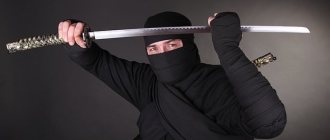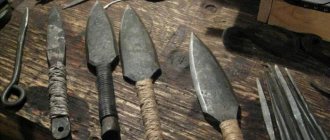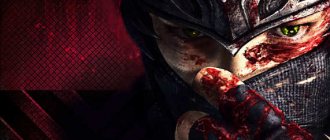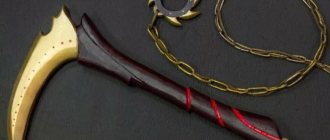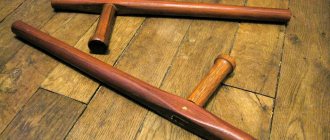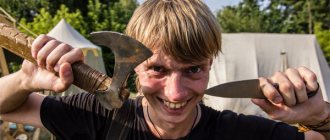Classifications
Star-shaped shurikens are classified according to the following criteria:
a) for the device as a whole: solid (solid) and folding, consisting of several prefabricated elements, brought into firing position using a push-button spring mechanism; with and without a hole in the base;
b) by design: with a classically expressed base and teeth and with an unexpressed base and teeth, where the base is a direct continuation of the teeth and vice versa without a pronounced boundary between them;
Design
Shurikens consist of bases with or without a hole, teeth with a tip, usually sharpened on one side.
A special feature of the design of shurikens is their flat surface, which provides a “wing” effect in flight when thrown with a twist, which makes it possible to throw it over a long distance. The presence of numerous teeth, ensuring almost 100% defeat, unlike single-blade throwing melee weapons. The relative roundness in general and the symmetry of the elements ensure flight stability, guaranteeing, if you have skills in the throwing technique, aim.[2]
Shurikens in Russia
In Russia, there is a restriction - if the rays on a ninja star are more than 8 millimeters, it is considered a bladed weapon, and you cannot buy such a shuriken without a hunting license. In Russia, possession of a metal sprocket is punishable by six years in prison, so everyone practices using rubber ones. And they fly almost the same way.
Japanese warriors developed a special technique not only for fighting with shurikens, but also for protecting against them. They use a wooden shield for this. During his performances, martial artist Nito a Cosima uses all types of so-called ninja weapons. Kusarigama is one of them.
Shurikens in ninja weapons
In the arsenal of the ninja, according to the chronicles, there were a lot of bladed weapons. It is represented by swords, sickles, pipes and throwing shurikens. This does not mean that the ninja had the entire arsenal with him. On secret missions, saboteurs took only those weapons that could be hidden in their clothes.
Ninja weapons include:
- Gatana is a sword with a short and curved blade;
- Ashiko – metal “claws” for overcoming vertical obstacles;
- Kakute - a ring with jagged edges in which poison was stored;
- Kama is a cutting weapon similar to a scythe;
- Kusari-gama is a similar scythe, only with a chain and a weight on the handle (with this chain the ninja knocked the weapon out of the enemy’s hands);
- Kaginawa - a hook on a rope designed to overcome vertical obstacles;
- Kieketsu-shoge - a hook and a ring connected by a rope;
- Naginata - Japanese halberd;
- Neko-te - metal claws with poison;
- Sai – trident;
- Shobo is a metal stick, sharpened on both sides, with a ring in the middle;
- Tanto is a small knife;
- Shurikens are throwing weapons.
Ninja weapons
Chronicles dedicated to ninjas tell about many types of edged combat weapons in their arsenal. The warriors had a variety of swords, sickles, pipes, and throwing shurikens. But in reality, the “night shadows” used only a few types of military weapons. They were easy to hide in clothes, and the enemy received unexpected “surprises” in a battle with a ninja. Other types of weapons were used equally by samurai and bandits.
Ninja weapons:
- Gatana. This is the name of a sword that has a short, curved blade. The metal handle is wrapped in strips of leather. In order not to attract attention to the owner, the weapon was not decorated with ornaments or jewelry. Very often, the saya (sheath) was larger than the blade; usually, throwing devices, poisons or documents were hidden at the bottom - everything that could help a ninja in a difficult situation.
- Ashiko (claws) - a metal device worn on the legs, making it easy for the ninja to climb walls and trees. During the defense they inflicted severe injuries on the enemy. A similar device, shuko, was only worn on the fingers.
- Kakute is a type of weapon used by female ninjas. It was a ring with pointed protrusions; toxic substances were applied to them.
- Kama. The weapon is similar to a scythe, the handle size is 45 cm.
- Kusari-gama. Similar to a kama, the only difference being that a chain with a weight was attached to the handle, which was used to knock out weapons from the enemy at a short distance.
- Kaginawa. The device was a cat; a rope or chain was tied to a hook. It helped to overcome walls and climb tall trees.
- Kieketsu-shoge. A knife was tied to a chain or rope at one end, and a hoop-shaped handle to the other.
- Naginata - This is the name of a Japanese halberd with a blade 15 cm long. It was mainly used by Sohei warrior monks. Ninjas used the naginata when they disguised themselves as these monks.
- Some people. Metal claws that fit on the fingers. In some cases they were smeared with poison. More often, such weapons were used by female ninjakunoichi, with which they struck the enemy’s eyes.
- Sai. A trident with a round or multifaceted shaft 60 cm long, with sharpened guards.
- Shobo. A metal rod with sharp ends and a ring in the middle, worn on the middle finger of a ninja's hand.
- Tanto. A small knife, the same kind that samurai used. Ninjas also used shibaki-yari - striking spears 1.5 meters long.
Types of shuriken
There are a huge number of types of throwing weapons known in Japan. Shurikens here are divided into two large varieties, Bo-shuriken and Shaken. The first category looks unusual for ninjas accustomed to the star shape. These types of shuriken are essentially small throwing spears or sharpened bars of iron of a certain shape.
See also the article Handcuffs, their description and characteristics
What is the name of the big shuriken?
- kugi-gata , the prototype was a nail;
- ari-gata , derived from needle;
- tango-gata , shaped like a knife;
- oko-gata , resembling a spear;
- matsuba-gata , or pine needle, something like a huge splinter.
Bo-shuriken in the museum The second category includes several dozen forms and varieties, since these are the familiar “ninja stars”.
Shakens, or hira shurikens, are the main varieties. The following are the names of ninja stars:
- hisi-gan, made from small coins;
Hishi-gan next to a coin for comparison
- kugi-nuki , the base part of a carpenter's tool;
Photo shuriken Kugi-nuki
- tetsumari shuriken , a pair of metal rings shaped like a windmill;
- manji-shuriken had poison on the blade to guarantee the defeat of the enemy;
- and what not...
What shurikens look like, photos of different shapes Shurikens are also divided by shape, from a circle to multi-bladed stars of a curved shape. It is interesting that almost no ancient shurikens have survived to this day. The reason for making them from bad metal is that the weapons are sprockets, essentially disposable.
Antique shureken from the Edo period
Origin
Despite the fact that a huge amount of research has been done, the origin of bo shuriken in Japan remains a mystery. This is partly due to the fact that the art of shuriken-jutsu is kept secret, but also because ancient Japan had many inventors of throwing weapons. The first school mentioned is Ganritsu Ryu (17th century). The surviving examples of blades from this school represent something between an arrow and a needle used in leatherwork.
Also in early references, for example, in the Osaka Gunki, there are records of short knives and swords that were used as throwing weapons, as well as how the samurai Miyamoto Musashi killed his opponent with a precise throw in one of the fights.
Modern shurikens are made of stainless steel. They can be purchased at many gun stores in Europe and North America, but in many states, such as California, owning shurikens is illegal.[1]
Ninja Art: How to Throw Throwing Stars Correctly
How to throw a throwing star
Shuriken is an ancient Japanese weapon, better known today as a throwing star. They were used by ninjas in addition to swords. Shuriken are extremely dangerous and are banned in many countries. If throwing shurikens correctly and within the limits of the law, this art can become an important part of the study of martial arts. To learn how to throw shuriken, follow the steps below.
Find the right target
Throwing stars stick well into objects that they can pierce. Drywall or a piece of plywood works well as a target. Draw a target or some kind of silhouette, after which you can begin training your accuracy. Place the target in a deserted place where there are no fragile things. Do not allow other people to be in close proximity to you or your target while working with throwing stars.
Select throwing stars
First, make sure that their use is legal where you live. Shurikens have four to eight spines. Shurikens with more spikes are preferable. A shuriken does not have to be razor sharp to be used successfully. Blunt edges often hold up even better, and you won't cut your fingers on them. Thick, heavy stars with very sharp edges are much more difficult to throw. Choose flat shurikens with a simple shape. They fly better.
Hold the shuriken firmly between your thumb and bent index finger.
Concentrate on the point on the target you want to hit. Bring your hand with the star out to your sides while bending your wrists inward. In one motion, shift your weight to your front foot and throw your wrist and arm toward the target. The shuriken must be released exactly at the moment when your arm is fully straightened and parallel to the ground. You must point your hand exactly at the point you were aiming at. Concentrate on throwing the star very sharply, so that it rotates quickly in flight. The correct rotation of the star is much more important than the force put into the throw. The twisted star will fly in one line and hit the target. A star, which was simply thrown somewhere with all its might, can fly anywhere.
Once you gain experience, try using the same technique to throw a few stars
When you learn how to throw one shuriken well, start trying to quickly throw several in turn. In your other hand, take a stack of throwing stars. Having thrown out one shuriken, turn your hand to the stack of remaining ones and take the top one. Throw all the shurikens as quickly as possible, while paying close attention to the throwing technique. Your body needs to move a lot. Only the hand should participate in throwing stars.
If you're having trouble with your side throw, try the overhand throw technique.
If you are right-handed, stand with your left foot forward. Hold the throwing star between the thumb and bent index finger of your right hand. Raise your hand above your shoulder. Focus on the target point where you want to stick the star. At the same time, shift your weight forward onto your left leg and sharply straighten and move your arm down. You need to release the star at the moment when your forearm is exactly perpendicular to the ground. This point is very important, it affects the accuracy of the throw. Try to spin the shuriken while throwing. A fast-spinning shuriken flies better and does not go astray. If you are left-handed, change your stance to the opposite one.
Remember, the article does not call for intentional harm to the health of other people, the information is provided for informational purposes only.
Research methodology
The method of studying shurikens is similar to the general method of studying edged weapons, but it has a number of its own specific features due to the design and method of control and action. In this regard, for shurikens to be recognized as edged weapons, they must have the following conditions:
1. The weight of small shurikens must be at least 60 g. With an increase in the diameter of the shuriken by 1 cm, the weight should increase by 10 g in direct proportion.
2. They must be flat with a smooth surface, and its elements must be symmetrical, ensuring rectilinear-translational, rotational movement in flight when throwing with a twist, that is, ensuring flight range and stability, as well as aiming of throwing when used for its intended purpose.
H. They must be made of durable (hard and rigid) metal, not deform or collapse when tested for strength with the application of a force equal to the strength of an adult man. For this purpose, shuriken is tested for fracture and bending in two ways. In the first, the left half of the shuriken is clamped in the left hand and the right half in the right hand. A force opposite to each other is applied simultaneously to each of the halves by both the left and right hands. Moreover, if the right hand applies force from bottom to top, then the left hand applies force from top to bottom. In the second case, the shuriken is fixed in the hands in a similar way, but the right hand applies force from right to left, and the left hand simultaneously from left to right. Along with this, the shuriken should not be deformed or destroyed when meeting a relatively rigid obstacle (a biomaterial substitute, a dry pine board, etc.) when thrown with the maximum effort of an adult man from a distance of 3-4 meters. If, during the above tests, deformation and destruction of the shuriken, both as a whole and its individual teeth, does not occur, it is considered strong enough for reliable use for its intended purpose...
4. Shuriken teeth must have at least one blade with at least one-sided sharpening; the ends must be sharp, ensuring penetration into an obstacle (target, board) to a depth of at least 5 mm when thrown with a twist from a distance of 3-4 meters.
5. Folding shurikens must have a working mechanism that reliably fixes its elements in the combat (unfolded) position.
6. The presence or absence of shuriken throwing skills in the persons from whom they are confiscated is not a forensic assessment criterion and cannot be used as the basis for conclusions about whether or not they belong to a bladed weapon.
